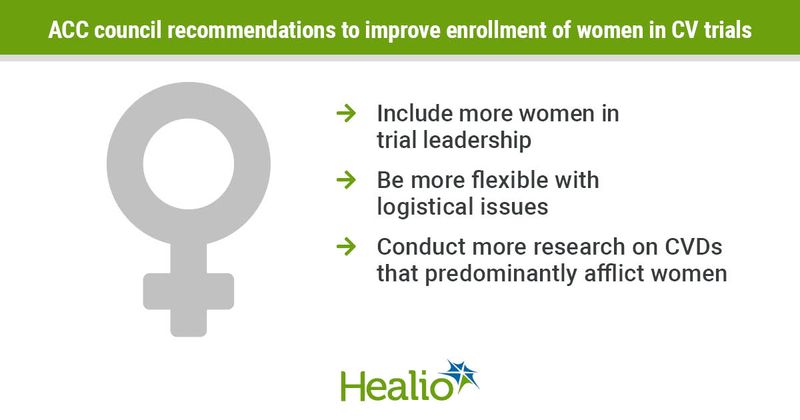ACC council recommends ways to improve enrollment of women in CVD clinical trials
Click Here to Manage Email Alerts
Studies showed that low enrollment of women in CVD clinical trials may be influenced by myriad clinical, racial and community-related factors, according to a perspective published in the Journal of the American College of Cardiology.

Leslie Cho, MD, director of the Cleveland Clinic’s Women’s Cardiovascular Center, and colleagues on the American College of Cardiology’s Cardiovascular Disease in Women Committee Leadership Council provided recommendations on how to improve enrollment and retention of women in CVD clinical trials.

“Enrollment of women in clinical trials is essential. Historically, nonreproductive medical research has been based on male data that are then extrapolated to women,” Cho and colleagues wrote. “However, differences between the sexes with regard to pharmacokinetics have been well described. ... The low participation of women in CVD trials, especially in studies with devices and procedures, has been well documented.”
The participation prevalence ratio (PPR) is a measure of the sex-specific prevalence of the CVD condition being studied, with a ratio of 0.8 to 1.2 suggesting good representation of women, according to the study.
One paper reported the following PPRs of women participants in various CVD trials:
- trials in ACS (PPR = 0.6);
- trials in atrial fibrillation (PPR = 0.8);
- trials in CAD (PPR = 0.6);
- trials in congestive HF (PPR = 0.5);
- trials in hypertension (PPR = 0.9); and
- trials in pulmonary hypertension (PPR = 1.4).
Moreover, another study reported that CV device and procedure trials had the lowest rates of women enrollment compared with medication and lifestyle trials (P = .0009).
As Healio previously reported, the extent of women’s inclusion in CV trials may be associated with such trial characteristics as funding/sponsor, disease type and age group.
The council identified eight potential barriers to adequate enrollment of women in CVD clinical trials and provided recommendations addressing each.
- Differential Care: Researchers should increase awareness of ongoing CVD trials to primary care providers and community and safety net hospitals and expand locations of trial enrollment.
- Ageism: Older patients are disproportionately represented in clinical trials, according to the council, and it is important that age and comorbidities be expanded in trial inclusion criteria to reflect the real-world patient population.
- Lack of awareness, trust and logistical barriers: Researchers may want to consider limiting the number of on-site visits and expanding use of telehealth; adjust to before or after work on-site visitation hours; and address participants’ concerns regarding logistical issues such as offering child or older adult care, flexible office hours, free transportation or at-home follow-up.
- Lack of diversity in trial leadership: Women are underrepresented in clinical trial leadership, according to the council, and studies have reported that HF trials with an elevated number of women authors also enrolled a greater number of women participants.
- Underrepresented minority women in CV trials: Inclusion of women from historically underrepresented groups will require a multipronged approach. Specific points include to increase the number of women from historically underrepresented groups in trial leadership; to utilize novel locations for trial enrollment; to minimize logistical barriers; and to increase engagement with community stakeholders and professional associations that represent these groups.
- Special considerations for women who are pregnant or of childbearing age: Researchers may consider further drug studies on pregnant animals so to extrapolate data before inclusion of pregnant women. The council added that obstetric, pharmacologic and maternal fetal medicine consultants should be included in the trial design of any study that includes women who are of childbearing age, pregnant or postpartum.
- Sex differences in disease: Further research is needed in CVDs that are specific to or predominantly afflict women, such as coronary artery dissection, HF with preserved ejection fraction, stress-induced cardiomyopathy and microvascular disease.
- Study retention: The council added that researchers should report on reasons for study drug discontinuation and withdrawal of consent in trial case reports and stratify the information by sex and race/ethnicity.
“To address barriers to recruitment and retention of women in CVD clinical trials, a comprehensive and targeted approach that involves partnership with all stakeholders — patients, referring clinicians, research teams (investigators and coordinators), health care systems, the FDA, payers, sponsors, professional and community organizations — is essential,” the council wrote. “We owe it to our patients to increase representation of women and underrepresented minorities in CVD trials.”
Please see the perspective in JACC for full details on the council’s recommendations.
References:
- Jin X, et al. Circulation. 2020;doi:10.1161/CIRCULATIONAHA.119.043594.
- Reza N, et al. Circ Heart Fail. 2020;doi:10.1161/CIRCHEARTFAILURE.119.006605.
- Scott PE, et al. J Am Coll Cardiol. 2018;doi:10.1016/j.jacc.2018.02.070.
- Yan L, et al. Circulation. 2020;doi:10.1161/CIRCULATIONAHA.119.043594.

